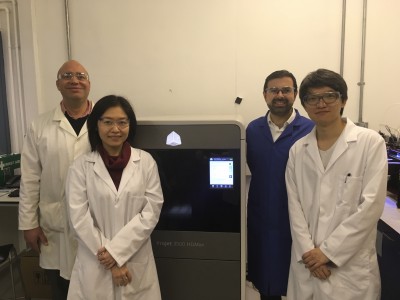Research from the UK’s University of Bath looks at additive manufacturing as a potential solution to the droughts seen across the world. The research examines how 3D printed membranes could be used for this purpose, specifically how 3D printing is applicable to reverse osmosis.
Reverse osmosis is the process used in order to desalinate water, separating salt from the liquid, and making it drinkable. The process is seen as an answer to the world’s growing demand for water. As an energy intensive technology it is used mostly by Saudi Arabia and the U.S at the moment. However, as of yet, this process does not typically use 3D printed membranes. This may change in the future, especially with researchers in Mexico also looking towards 3D printing.
The research was carried out at the British University’s Center for Advanced Separations Engineering (CASE), described as the ‘largest academic group in Europe focused on advancing fundamental and applied scientific, and technological developments in separation‘. While there are other techniques being used, such as in recent years California have implemented 96 million plastic ‘shade balls’ in order to mitigate the effects of drought and keep hold of their water reserves. Reverse osmosis is perhaps the most effective method in that it can convert readily available seawater into drinkable liquid.
The research has major implications for the agriculture industry since according to the Guardian newspaper, 70% of world water use is for agriculture.

Why 3D printing?
3D printing of complex patterns that are required for the membranes. Although not traditionally used for desalination plants, the researchers have looked towards 3D printing for similar reasons as Rocket Crafters. The space technology start-up have recently utilised additive manufacturing to create specific geometric patterns for 3D printed rocket fuel. The University explains that,
The use of additive manufacturing techniques could provide more control towards the design of separation membrane systems and offers novel membrane preparation techniques that are able to produce membranes of different shapes, types and designs which cannot be made using conventional techniques such as phase inversion or sintering.
Desalination technique
Membranes are selective barriers, semi-permeable in nature. These sheet-like structures act as filters stopping salt and other minerals from passing through. Currently, desalination is a very energy-intensive procedure thus making the process very expensive. However, with water being perhaps the most vital natural resource, efforts to refine this technique are ongoing and this research is evidence of that.
The research hopes to innovate current desalination techniques since,
Membranes are currently restricted mainly to tubular/hollow fibre and flat surface configurations due to the limitations of current manufacturing processes. As a result, the precision of present membranes are limited in successfully separating certain properties.

What is required?
In order to be successful the research paper, titled ‘Perspective on 3D printing of separation membranes and comparison to related unconventional fabrication techniques’, identifies a criteria relating to technology and materials. Identifying that “Composite materials with sufficient mechanical strength are to be prepared to ensure that the membrane produced remains stable while the thickness is reduced.” In terms of technology used, they explain ‘jet focusing by hydrodynamic and pyro-electrohydrodynamic shooting are potential future technologies that could enable sub-micrometre resolution for material jetting printers.’
Conclusion of the research
The research paper evaluates current 3D printing technology and how it benefits desalination projects. However, one aspect that cannot be provided by the current technology is low cost. Additive manufacturing signals a high-cost procedure in order to create the membranes which is currently a prohibitive element of the project. The researchers have concluded that work is ongoing, with additive manufacturing having
…the potential to provide a unique set of membranes that will extend the possibilities of membrane-based separations beyond the current state-of-the-art.
In the future then, rather than using plastic shade balls to stop the effects of evaporation, Californian desalination plants may be looking towards additive manufacturing their membranes.
Featured image shows the ‘largest seawater desalination plant in the world’, The Ras Al-Khair Water Station in Saudi Arabia. Image via Susris.



